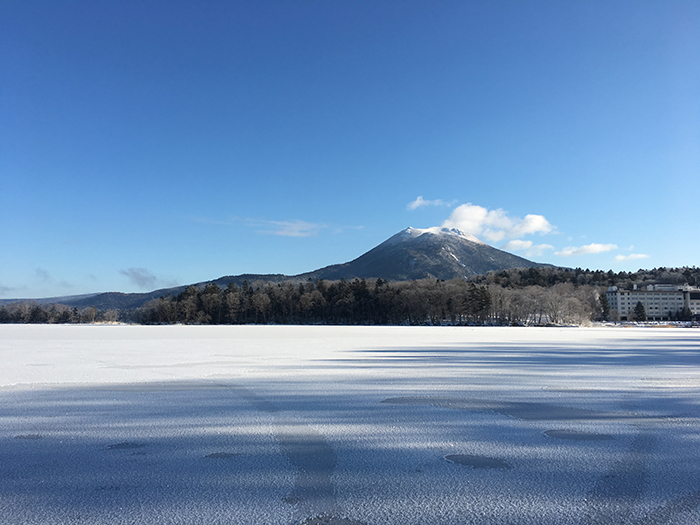東京で「アイヌ クラフツ」を売る!地産外商のプロジェクトプロデュース
阿寒湖アイヌ工芸作家とセレクトショップBEAMSのレーベル「fennica(フェニカ )」とのプロジェクト。
前回までに「地産外商」を目指すに至った地域の課題背景や、アイヌ文化が受け継いできたサステナブルな価値観をコアに据えプロジェクトを駆動する「チーミング」についてお伝えしてきました。
第3回では、ビジョンを具現化するための施策と、そこに見いだされる「地域活性化への示唆」をご紹介していきます。カギとなるのは、地域と外部との新しい座組みと、プレーヤーのモチベーションビルディングです。
fennicaビームスとの出合いがブレークスルー
「既存品にマークを貼るような、うわべだけのコラボはしません」。fennicaディレクターの北村恵子さんが、われわれとの最初の対面で言われたことです。プロジェクト具現化のための協業を、日本のカルチャー発信に注力しているビームスに打診したところ、fennicaとの取り組みを提案いただきました。さまざまなライフスタイル提案を行っているビームスにおいて、fennicaは世界各地のクラフトを見いだし、高いレベルでビジネスとしているレーベルです。
「作家の方々と向き合い、時間をかけて対話しながら、私たちがつくってほしいものであり、作家のつくりたいものを目指したい」。北村さんの言葉は、各地の工芸作家と向き合い続けてきたfennicaが大切にしているビジョンそのものでした。
サステナブルな観光資源・産業づくりを目指す本プロジェクトの方針とも合います。アイヌ工芸にかねて関心の深かったfennicaの意向とも合致し、ビームスと電通の協業パートナーとしてのこれまでにない取り組みが本格的に開始しました。
アイヌ作家とfennicaとの信頼関係が生んだものづくり
阿寒湖温泉に駐在していた電通・森尾氏(第1回執筆者)と共にfennicaのディレクターであるテリー・エリスさんと北村さん、コーディネーターの方とで作家の方々を訪問したのが2017年の秋でした。そこから何度も阿寒湖に足を運び、6人の作家それぞれと対話を重ね、アイデアを引き出していきました。
日常は観光関連の仕事にも携わる作家の皆さん。その両立の中で制作する作家の方々のペースを考慮してものづくりを進めました。fennicaのお二人のアイヌの伝統や作家への深い理解・尊敬がお互いの信頼関係を生み出していきました。作家との関係を徐々に詰め、双方の意思を確認しながら具体的な作品が見えてきたのは始動から約1年たった頃でした。

本当にビジョンが形になるの?? ステークホルダー全体と共有したこと
作家の他にも地元でプロジェクトに関わったプレーヤーは多岐にわたります。阿寒観光協会、釧路市、釧路信用金庫、コーディネーター、カメラマン、ライター…。2年超におよぶ息が長く距離も遠く、さまざまなステークホルダーが関わるこのプロジェクトをどう動かしたか?fennica・ビームスチームの熱意があったのはもちろんのこと、電通チームでも大きく二つのポイントでプロジェクトを駆動していきました。
一つは店頭で売られるイメージをみんなで共有すること。
作品が売られる場所、手に取ってくれるお客さんを実感してもらうために、東京での視察プログラムを組みました。fennica店頭見学やfennicaブランドの説明の他、ライフスタイルの流れを読む雑誌編集長によるトレンドに関する講義、ライフスタイルショップ見学、工芸にまつわるミュージアム巡りなど…。作家だけでなくステークホルダーの皆さんで一緒に回って体験し、感想を共有しました。
作家にとっては地域や時間軸を超えたさまざまな工芸や民芸を見て体感することで、作品のヒントとして自らに取り入れたり、相対的に自己を評価することで、より高みを目指す機会ともなりました。それぞれにイメージを膨らませることで、1年以上先のローンチに向けたモチベーションとしてもらうことを狙いました。
また雑誌編集長が話された中で、今の物の買われ方について印象に残った点がありました。「誰がつくっているかに関心が移り、つくり手自身のライフスタイルへの共感からモノが買われる」「商品を通じて、つくり手が好きなことや大切にしていることといったストーリー自体が消費されている」というお話です。この視点から、作家の持つストーリーを深掘りして紹介するというPR戦略にも結び付いていきました。
もう一つのポイントは、ビジョンや広がりを共有すること。
ビジョンや言葉の有効性は第2回でもお伝えしましたが、加えて世の中への広がりについても早くから準備を進め共有に務めました。電通の得意とするPR領域で、メディアでの露出計画を、このプロジェクトを積極的に支え続けた釧路信用金庫の皆さんをはじめとした方々に積極的に伝えることで、fennicaの店頭とそこからさらに世の中に広がっていくことを具体的にイメージしてもらいました。
メディアからの反応が後押しに
プロジェクトが進行していくに当たり、情報を聞きつけた地元メディアがいち早く取材したこと、また初期からNHKの取材クルーが密着したこともモチベーションにつながったと考えています。これらはビームス×アイヌという座組みの新規さや意外感に加え、社会性を付与できたことが要因です。
「阿寒湖Next Generation」のビジョンがあり、それを地元の観光協会や自治体、信用金庫といった地域社会を支えるプレーヤーが後押しする取り組みであったことで、“斬新なコラボ”の一面にとどまらない、“地域の未来に関わる新しい取り組み”としてメディアからも受け取られた要因だと考えています。
これら売り場イメージの共有やメディアへの施策を通して、ゆるやかで確かな意識形成を図りました。作家のみならず、関わる人たち全員のモチベーションに結び付くものです。それぞれの立場で専門性を発揮し、プロジェクトをゴールに向かって進めていくために、このようなモチベーションビルディングは重要な位置付けでした。
プロジェクトを伝えていくPR戦略
商品づくりが進みfennica店舗でのローンチ時期が2019年10月と決まりました。
いいものができつつある確信をもとに、ではプロジェクトのお披露目をどう伝えていくか?
電通PRのチームも交え議論し、PR発信を中心に据えていくことを決めました。
地元阿寒湖にとっては新たな産業や観光につながる点、またfennicaでは新しいライフスタイルアイテムがアイヌ作家と共に登場する点というように、さまざまな視点で捉えた本プロジェクトの特性を生かした戦略です。
リリースの中にも「ビームス×アイヌのコラボレーション」「アイヌ文化と工芸作家」「阿寒湖観光」というプロジェクトの核をもとに、「工芸・ものづくり」「ライフスタイルアイテム」「地域経済の担い手」などの切り口を意識した要素を盛り込んで、メディアへのアプローチを実施しました。
結果、ライフスタイル誌、男性・女性ファッション誌やウェブサイト、経済新聞や地元新聞など幅広いターゲット層に届くメディアでの露出を獲得。fennica・ビームスブランドのもつ発信力と作家・作品の魅力、阿寒湖の魅力などプロジェクトに内包されたさまざまな発信力がもたらした成果です。各メディアの視点で取材し、魅力を紹介してもらえたことは、ローンチの告知にとどまらず、阿寒湖地域や作家の方々の今後の資産にもなっていくものでした。
「AINU CRAFTS」いよいよ世の中へ
2019年10月13日、新宿のビームス ジャパンのfennica店頭に2年にわたって試作、制作を進めてきた数々の作品が並びました。
同時に同じフロアの展示スペース「Bギャラリー」でもアイヌ工芸や阿寒湖の映像を展示するイベントが開催されました。売り場とギャラリースペースが連動したことで、より広がりを持った阿寒湖・アイヌ文化の展示となりました。

オープン早々から店頭にはたくさんのfennicaファンのお客さま、またメディアで知ったという新規のお客さまも店頭に訪れ、商品を手にしていました。購入される方が続出し、高額な商品も会期中にほとんどが売れていくという結果になりました。
期間中、作家にとどまらず歌い手としても活動する姉妹ユニット「KAPIW&APAPPO」によるウポポ(アイヌ民謡)のライブや、最終日にはプロジェクトに参加した阿寒湖と旭川の作家とfennicaディレクター、Bギャラリーキュレーターによるトークイベントも行われました。たくさんのお客さまに、作家の思いや阿寒湖の魅力、アイヌ文化、アイヌのものづくりのことを伝え、盛況のうちにイベントは終了しました。

会期終了後、すでにfennicaを訪れたお客さまから追加の注文が入っています。作家への仕事が継続して発生し、地域産業への寄与が早速見られています。これまで東京から見れば“観光地”としての阿寒湖だったのが、文化の面でも経済の面でも“交流地”となり始めたといえるのではないでしょうか。この「AINU CRAFTS」プロジェクトは今後も継続していく予定です。
2年にわたるプロジェクトを通して見た地域活性化につながるヒント
これまでの3回にわたり連載でお届けしてきました。もしかすると「アイヌ文化という強力なアイデンティティーがあればこそ」このような独自の取組みができるのでは…と思われた方があるかもしれません。しかしさまざまな地域活性化の取組みにとって、いくつかの有効な示唆となるポイントを含むと考え、この場でご紹介をしてきました。
本連載で語ったことをまとめて振り返りますと
① 地域の課題を捉え、今何が必要かを設定すること(第1回:地産外商)
② 地域資産を分析し、何をコアにしていくかを設定すること(第2回:アイヌのサステナビリティ=現代のバイブル)
③ 長期的かつ柔軟な視点でプロジェクトに取り組む組織体制・マインド(第2回:ティール組織とビジョン構築)
をお伝えしてきました。
第3回では
④ 新たな座組みによって、ブレークスルーを起こすこと
⑤ 実現に向けたゆるやかで確かな意識形成を行い、推進していくこと
⑥ メディアを巻き込んだ情報発信を戦略的に仕掛けること
これらがそろうことで地域の新しい光が見えてくることをお伝えしてきました。
こう書くと一見当たり前のことを並べたように見えるかもしれませんが、実際に地域の誰を巻き込むのか?外の誰と仕掛けるのか?それをどのように駆動し展開して形にしていくのか?そうしたところにお悩みの地域のご担当者の方は多いと推察します。
ここでお話した地域資産としての「アイヌ文化」を、ご自身の地域にある独自の資産と置き換えて考え、本プロジェクトから見えるステップをご自身の地域活性化に向けてご参考にしていただけたら幸いです。
地域のプレーヤーにとって活躍の場が見いだされ、彼らの活力が地域の産業振興につながることが地域活性化だと私は捉えます。地域が抱える課題に対しては、電通の持つネットワークや広告で培った課題発見・コミュニケーションスキルやプロジェクトプロデュース力が活かせるのではないかと考えています。
結びに 果たして観光資源はつくれたか?
阿寒湖温泉地域の産業における、新たなブレークスルーを生むプロジェクトをご紹介してきました。しかし将来に向け継続した取り組みと情報発信を絶やさないことは、今後も課題になります。
地域の新しい観光資源づくりとなったか?その結果は、もしかしたら少し後に表れることかもしれません。もしもメディアの情報やこの記事に触れて興味を持っていただいた方がありましたら、ぜひ阿寒湖へおでかけください。夏の道東のすがすがしい空気と国立公園の緑もとても気持ちがいいですし、冬のマイナス30度の世界も素晴らしいものです。アイヌの皆さんが暮らす土地で、ぜひ「AINU CRAFTS」の生まれる現場を体験してみてください。

この記事は参考になりましたか?
著者

宮崎 暢
株式会社 電通
ビジネストランスフォーメーション・クリエ―ティブ・センター
クリエーティブプランナー
電通入社後、雑誌担当の経験を生かし、編集者との協業により多様な業種のクライアントのコンテンツ開発、キャンペーンプランニングを実施。2018年より地域のブランディングを支援する産学協働プロジェクト「電通abic project」に参加、2022年より代表。北海道から九州まで国内各地の地域資産を再編集し、地域のプレーヤーとの協業・共創によりブランディングするプロジェクトのプランニング・推進を手掛ける。



